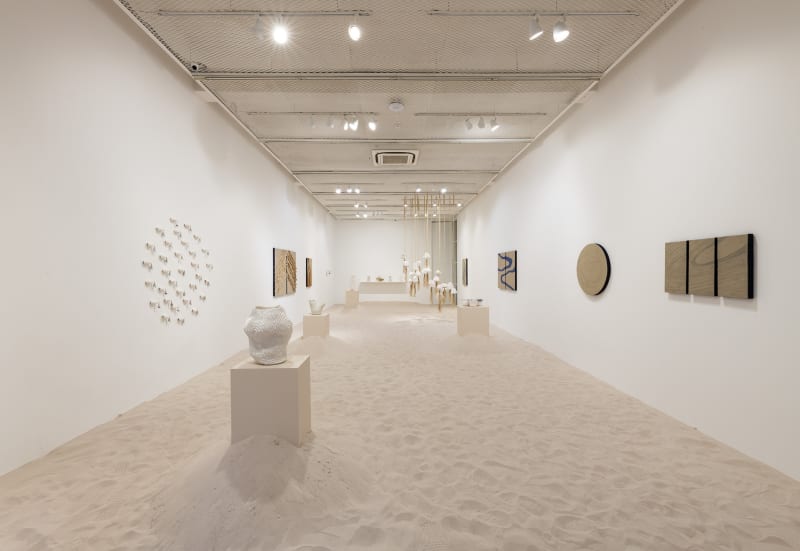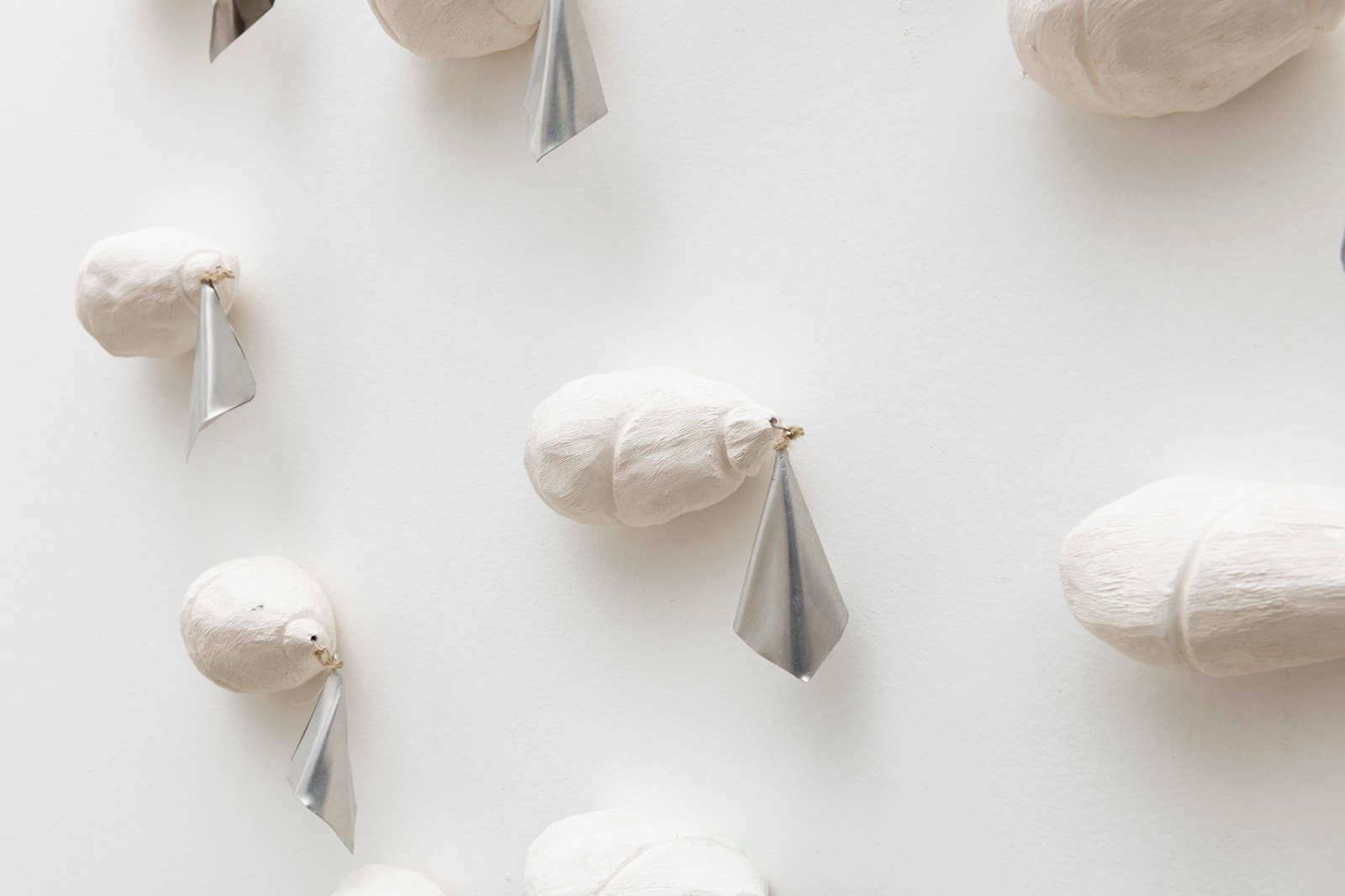Gabriella Marinho: Luminous Trail
Gabriella Marinho: luminous trail
Gabriella Marinho (Niterói, 1993) understands art as “a catalyst for details” that serves as an instrument for the reclaiming of existences and permanencies. In her work, the artist uses clay to create a lexicon that is both metaphorical and material, strengthening links between ancestry and corporeality. Gabriella rethinks the knowledge contained in the handling of earthen materials—knowledge that transcends time beyond the earliest records in history—in a gesture that restores the possibility of self-determination to the bodies of Black people. Through paintings, photoperformances, installations, and sculptures, the artist invites the public to immerse themselves in a meditative state of introspection and rest, speculating a pause in the intense daily rhythm to encounter the human spiritual dimension. Her solo exhibition at Galatea—carefully presented as part of the gallery's curatorial program, which affirms its commitment to the most recent Brazilian artistic production—showcases a2 fragment of her extensive research in a way that is unprecedented within the context of the city of São Paulo.
As possible paths beyond the current senses of belonging and self-knowledge, Gabriella conducts her practice as a way of developing a sense of self in communion with the spiritual traditions of Candomblé. Using earth and sand collected from various locations, she overlays the diversity of territorial constructions, suggesting a displacement that is visible in her compositions. Luminous trail, the title of the exhibition, makes an ambiguous and prolific reference to the image of the secretions left by the snails on their paths. The artist presents us with an image that, while open to the most diverse interpretations, returns to the sentience and meanings of spirituality of African origin.
Black people in Brazilian national territory often recognize themselves as descendants of different peoples from the African continent, brought over in the violent context of the colonial diaspora. The forced transatlantic displacement of enslaved Africans to the Americas contributes as a fundamental pillar to the hegemonic production of the socioeconomic organization centered on capital. This way of living, based on expropriation and alienation, unfolding through the speculative valorization of working time, structures the hierarchy and segregation of different social groups.
This historicity surrounding the bodies of people who identify as Black, increasingly reflected in public spaces—such as social policies aimed at repairing the effects of this period—sometimes takes on personal meanings in the construction of bonds with cultural and spiritual traditions of African origin recreated and continued in Brazil. The various Candomblé nations—such as Ketu, from the Yoruba traditions; Jeje, from the cultures originating from present-day Benin and surrounding areas; the nation of Angola, from the Bantu peoples; among others—are fundamental to recognizing the continuity, permanence, and influence of African cultures in the formation of what is understood today as Brazilian culture.
Contrary to the ideological conservatism that sustains modern forms of social organization, the continuity of cultural traditions of African origin is renewed through the virtuality and plasticity of each body in relation to its experience of the world. Nonetheless, these are traditions transmitted orally—that is, they do not depend on a medium “external” to the body, as writing does—and are shaped by the vibration of the vocal cords of those who voice them, always in what is conventionally called the “present.”
Ancestry, reimagined and reinvented through orality as a living technology of transmission, finds its echoes through Gabriella's artistic practice. Through a careful listening to what ancestral knowledge has to say beyond writing—within the vibration of the body and the sensibility of gesture—the same virtuality that animates the African oral tradition, in which the word throbs in the now, embodied, reverberates in the handling of clay and in the choice of white as an imperative keynote in this exhibition, a vocabulary attuned to spiritual traditions. In this dialogue, the work becomes a means of enunciation: the material and symbolic elements that make up its installations offer themselves as records of an ancestral memory that is not fixed in the past, but transforms into a creative and caring presence, just like the spoken word, or like the igbín, which carries in its spiral the doubled time of existence.
In her intimacy with the material, revealed by the creases of the hands that mold the porcelain ceramics, the artist makes an association between white and the igbín—snail, in Yoruba—, outlining an investigation of the morphosyntax referring to the symbols of Oxalá, the oldest orixá—deity, in Candomblé—, and father of all the other orixás of Orum—in Candomblé, the spiritual world. Ibis, a circle-shaped installation of snail shells with aluminum tips, and Snail Head, a glazed ceramic sculpture, reflect this resplendent field of creative energy as being the same as that of protection and care. The high density forged by extremely high temperatures, combined with the fragility of the resulting porcelain material, embodies the patience, introspection, and determination of people who have lived for long periods—as well as the luminance of the white color, a combination of all colors that envelops us in a peaceful atmosphere.
Faced by the undeniable interruption projected by modern subjectivity for black people to give meaning to themselves, available notions of ancestry are widely used; whether out of a desire for spiritual reconnection in the face of the colonial anxieties of civilization's malaise, or out of the need to rebel against the devices that shape and govern modern subjectivity. If, in Augustinian thought, interiority presents itself as the place of divine illumination, and in Freudian psychoanalysis it unfolds as a split space guided by drives to be organized by the subject itself, Gabriella's work proposes another spatiality—not centered on the enclosure or transparency of the “self,” but on the intertwining between ancestry and matter, in a process of self-knowledge that is relational and not self-centered.
Aligned with a cosmology that understands ancestry as interspecific—that is, an amalgamation of other more-than-human, plant, mineral, and energetic species—, Gabriella's practice is not limited to an aesthetic gesture. It activates an ethical, ontological and epistemic field that tensions the very historical forms of construction of the subject. The hanging objects among landscapes of sisal and indigo in Cascade, or the topographical sinuosities in sculptures and paintings that directly evoke the presence of the places visited in the Trails series, are, for example, possible scores for this choreography of spiraling time—to evoke, simultaneously, the poetics of the body-screen of Leda Maria Martins and the drawings on snail shells.
When we revisit the foundations of modern subjectivity that justify relations of domination with objects—the same as the logic of expropriation and enslavement of African people—, the illumination of interiority appears as a revelation of truth, as well described by the philosophical tradition of Saint Augustine in the relationship between personal confession and superhuman divinity. Here, Gabriella presents us with a turning point in this thought through the fluid that leaves traces in its path, as it reveals itself to visibility in a relational aspect between light, focal point of vision and what is [not] seen. In this signifier that refers to Oxalá, a body that leaves traces, which may or may not be perceived, opens space for the ruin of modern subjectivity, while undoing the reciprocal field of introjection and projection verified by psychoanalysis.
In this regard, the artist also offers us a gap for a different starting point for the meanings: the snail does not represent Oxalá, but it is Oxalá, interrupting the categorical operation of modern knowledge that separates and represents as a significant moment of subjugation. From this observation, it is also possible to establish dialogues between Gabriella's work and Denise Ferreira da Silva's racial criticism, in which raciality is positioned as a fundamental touchstone for the formation of the modern scientific subject, diluting the counterpoint between transparency—reserved for the supposed universality of European culture—and affectability—attributed to cultural difference, and, consequently, to all non-white bodies.
The use of various materials combined with clay, such as aluminum, coastal straw, sisal, waji, cowrie shells, among others, makes direct references to the spiritual elements of Candomblé terreiros (temples, in Candomblé). The trails that the artist follows towards this ancestry common to the African continent appear as archives of corporeal visibility in the subjectivity of black people: traces of the situated nature of experience, understanding perception through its cultural and historical context. In light of Sartre's phenomenology and Frantz Fanon's analyses of the lived experience of blackness, the vision that translates into the awareness of being seen acts to conceal the subjectivity of racialized people, in which the black person is determined in an “external” way to themselves as such.
While offering itself to the gaze, Gabriella’s work also disorients it through a state of rapture, dissolving the boundaries between the inside and the outside of the self. Against the logic of colonialist racism, which, according to Fanon, disorganizes the body schema of the black subject and compromises their action in the world, Gabriella develops a plastic and symbolic response that reaffirms presence and reorganizes agency, investing in materiality as a vehicle for reordering the realm of the sensible. As uprisings for freedom in the settlements of the terreiros, African traditions guide the collective forms of meaning for the lives of the people who worship and live through these meanings, just as the artist handles them.
What message is conveyed by a body that inscribes itself in space through time—slowly and impassively, like a snail? It is precisely to abandon the categorical descriptors that anchor modern knowledge that Gabriella molds ceramics, gathers earth, and perpetuates the luminous trail through a relationship of corporeality in her works. Among the sand dunes installed here to welcome visitors to the exhibition, Gabriella inscribes her transits as a way of ritualizing the meanings in her personal life. As the title of the sculpture states, Paths are like fingerprints; the artist denotes a field of particularity that shapes what is seen, further elaborating it for the collective sharing of this same sensitivity.
Ultimately, Gabriella Marinho’s work not only reaffirms the continuity of African-based cultural and spiritual traditions, but also intervenes in the technologies of subject formation, subverting the visual and conceptual field in which Black subjectivity has been historically confined. Light—such a cherished metaphor of modernity for the modus operandi of revealing truth—here appears as a form of opacity that safeguards the existential mysteries of Black ancestries. The luminous trail thus becomes an image of both escape and presence, a trace that resists capture by the modern logic of isolated interiority, yet insists on existing as energy, relation, flow, and living memory.
MATHEUS MORANI is a researcher and curator. Curator of Solar dos Abacaxis. Founder of ainda,lab, an experimental study group.


![Gabriella Marinho, Cabeça quente, cabeça fria [Hot mind, cool mind], 2025](https://artlogic-res.cloudinary.com/w_1600,h_1600,c_limit,f_auto,fl_lossy,q_auto/artlogicstorage/antoniabergamin/images/view/e4d098930b39524e38da043ecd290523j/galatea-gabriella-marinho-cabe-a-quente-cabe-a-fria-hot-mind-cool-mind-2025.jpg)
![Gabriella Marinho, Caminhos são como impressões digitais [Paths are like fingerprints], 2025](https://artlogic-res.cloudinary.com/w_1600,h_1600,c_limit,f_auto,fl_lossy,q_auto/artlogicstorage/antoniabergamin/images/view/18d21461655bc7e62243a6bbf4db6b13j/galatea-gabriella-marinho-caminhos-s-o-como-impress-es-digitais-paths-are-like-fingerprints-2025.jpg)
![Gabriella Marinho, Cascata [Cascade], 2024](https://artlogic-res.cloudinary.com/w_1600,h_1600,c_limit,f_auto,fl_lossy,q_auto/artlogicstorage/antoniabergamin/images/view/9c17c511a9888e30cfd31138df229895j/galatea-gabriella-marinho-cascata-cascade-2024.jpg)

